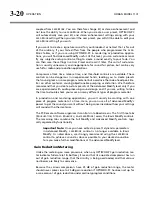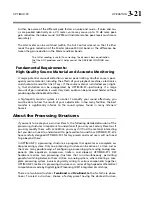
OPTIMOD-PC
OPERATION
3-7
We have supplied several presets tuned for the Microsoft WMA (V9) at 32 kbps. This
codec has severe artifacts (particularly with speech) at this bitrate and no preprocess-
ing can mask them completely. The 1101’s WMA presets strictly limit the amount of
high frequency energy applied to the codec, so these presets will sound dull com-
pared to other OPTIMOD-PC presets. To prevent the processing from adding L–R en-
ergy, these presets operate with full stereo coupling and without stereo enhance-
ment.
Professional netcasters committed to providing their audiences with the
best audio possible at a given bitrate should consider the use of a higher
performance codec like Orban’s Opticodec-PC, which uses standards-
based MPEG-4 AAC/HE-AAC/aacPlus™. HE-AAC is the most efficient codec
available at the time of this writing. It can provide good entertainment-
quality audio at bit rates as low as 32kbps stereo or 24kbps mono, allow-
ing coverage of audiences listening on dial-up connections or via wireless
devices. The lower bitrates also penetrate crowded networks with fewer
audio interruptions.
OPTIMOD-PC’s ability to maintain source-to-source spectral consistency is also an im-
portant advantage. Once you have set up the processing to minimize codec artifacts
caused by a given piece of program material, OPTIMOD-PC’s will automatically min-
imize codec artifacts with any program material.
All codecs add peak overshoot to the audio. This because they remove energy that is
psychoacoustically masked by the input audio. It is not unusual for low bit rate co-
decs to overshoot by 3 dB. To eliminate the possibility of clipping at the decoder, it
is wise to allow 3 dB of peak headroom at the encoder. In other words, set
OPTIMOD-PC’s output level control to –3 dBfs when driving an audio encoder.
Some decoders, such as the Dolby / Coding Technology’s HE-AAC decoder, contain a
limiter that prevents clipping if enabled.
OPTIMOD-PC in Radio-Oriented Applications: From Bach to Rock
OPTIMOD-PC can be adjusted so that the output sounds:
•
as close as possible to the input at all times (using the Two-Band Protection Lim-
iter preset)
•
open but more uniform in frequency balance (and often more dramatic) than the
input (using the Two-Band structure or running the Five-band structure with
slow release time)
•
dense, quite squashed, and very loud (using the Five-band structure with faster
release times)
The dense, loud setup will make the audio seem to jump out of car and table radios,
but may be fatiguing and invite tune-outs on higher quality home receivers. The
loudness/distortion trade-off explained above applies to any of these setups.
Summary of Contents for Optimod-PC 1101
Page 4: ......
Page 14: ......
Page 121: ...OPTIMOD PC OPERATION 3 1 Section 3 Operation Figure 3 1 The OPTIMOD PC Control Application...
Page 192: ...3 72 OPERATION ORBAN MODEL 1101...
Page 204: ......
Page 210: ......
Page 212: ...5 2 UNINSTALLATION ORBAN MODEL 1101...
Page 236: ......
















































